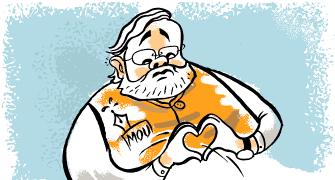The government's new-found confidence in making India a global hub for mobile phone manufacturing stems from the fact that it is offering one of the lowest corporate tax rates in southeast Asia, rectifying a persistent complaint from potential global investors.
It also has a large and growing domestic market, of which the competing manufacturing hub of Vietnam cannot boast, and an English-knowing labour force, but will that be enough?
Surajeet Das Gupta reports.

Just over a week after announcing a sharp cut in corporate tax for new investments to 15 per cent, Finance Minister Nirmala Sitaraman said she hoped global players, such as Apple Inc, would find it attractive to invest in India and bring in its manufacturing ecosystem.
Her call to Apple came a few days after Communications Minister Ravi Shankar Prasad announced that the US mobile phone giant would be entering the country in a big way.
To transform India into a mobile export hub, the government has to focus on the top five or six global players (Apple, Samsung, Huawei, Oppo, Vivo and Xiaomi) which account for 87 per cent of the global mobile phone production.
The government has engaged closely with Apple and Samsung, which account for 60 per cent of the global market.
The government's new-found confidence in making India a global hub for mobile phone manufacturing stems from the fact that it is offering one of the lowest corporate tax rates in southeast Asia, rectifying a persistent complaint from potential global investors.
It also has a large and growing domestic market, of which the competing manufacturing hub of Vietnam cannot boast, and an English-knowing labour force.
Will that be enough?
To put the issue into perspective: In 2018 India exported $1.07 billion worth of handsets, less than 3 per cent of Vietnam's handset exports ($37.60 billion), and less than one per cent of Chinese handset exports of $173 billion.
The two countries account for 82 per cent of mobile handset exports globally.
In 2014, the government set up a Fast Track Task Force (FTTF), which fixed a target of exporting over 120 million handsets worth $9.4 billion by 2019-20.
With Nokia putting in place a large unit for exports, many thought that target looked achievable, but the factory closed the same year following a tax dispute.
By 2018-19, data presented to NITI Aayog by the Internet and Mobile Association of India (IMAI) showed that India had achieved 15 per cent of the target by volume and 14.8 per cent by value.
Clearly, a policy that included a widely-publicised phased manufacturing programme to encourage local component manufacture had failed.
Now, however, the US-China trade war is creating new opportunities for India.
Apple, which makes almost all its iPhones in China, has been looking to hedge its bets by exploring alternative locations: India, Vietnam and a couple of smaller countries.
The size of the manufacturing opportunity can be gauged by the fact that 70 per cent of Apple's $265 billion revenues come from selling iPhones.
If, hypothetically, the Cupertino giant moved even 12 per cent of its iPhone manufacture to India, that would be equivalent to the total revenues from all mobile phones sold in India in 2018-19.
Apple has made a beginning with its partners Foxconn and Wistron in Chennai and Bengaluru respectively, manufacturing some of the older iPhone models, mostly for exports.
The plan is to progressively shift some part of the manufacture of its newer models too.
Says a top executive in the mobile manufacturing space: "Apple's sales in India are less than even a per cent of its total sales so it is not a big market for it and won't be in the near term.
"The company's focus is on using India as an export hub and that is where the big opportunity lies."
For South Korean giant Samsung, the story is slightly different.
In smartphone sales, it is a leading player in India, much ahead of Apple.
So it has a substantial domestic base and manufactures a small quantity for exports.
Samsung has already made big bets in Vietnam, its largest export hub, investing over $ 17 billion, most of it for handset manufacture.
In India, Samsung is likely to remain focused on the domestic market but it is also expanding exports.
It has invested Rs 5,000 crore in one of the world's largest mobile plants on the outskirts of Delhi, due to start production in 2020.
About a third of its annual capacity of 120 million mobile phones will be earmarked for exports.
It is also bringing in key component manufacturing facilities for mobile phone display and batteries at an additional investment of Rs 2,500 crore.
Chinese player Xiaomi, which sold over 100 million phones in five years in India, is exporting handsets on a pilot basis.
Manu Jain, Xiaomi vice-president, has openly said the company will assess how the government incentivises exports, given that local costs are higher than in China and Vietnam.
The lack of cost competitiveness is the chief hurdle to India's manufacturing dreams.
A study by Indian Cellular & Electronics Association (ICEA) puts the disability for a mobile handset manufacturer in India at between 10 and 12 per cent against Vietnam and 19-23 per cent against China.
Global players complain that effective power cost in India are 40 per cent higher (because of the need for back-up) than Vietnam and China, and both countries offer rental exemption of 15 years.
China even offers 40 per cent subsidy on plant and machinery.
"The Merchandise Exports from India Scheme (MEIS), which compensates for this disability, has been challenged in the World Trade Organization and, in any case, provides only 4 per cent on the f.o.b (free on board) value as incentive to handset makers," says a senior executive with a global mobile handset manufacturer.
In fact, the recent cut in corporate tax has not put India on a par with Vietnam.
Vietnam offers mobile handset manufacturers a four-year corporate tax exemption from the first year of profit, 5 per cent for the next nine years, 10 per cent for the next two years and finally settling at 25 per cent.
Even the PMP with its focus on "import substitution" through higher import duties of earmarked components, they say, has its limits.
ICEA in its communication with NITI Ayog has pointed out that PMP has reached limits beyond which its effectiveness is questionable and it has certainly dented India's competitiveness in exports.
Mobile manufacturers are now clamouring for PMP to be delayed till 2023.
With the government's earlier FTTF targets now buried, it has now come up with a new national electronics policy (NEP) this year.
And that has fixed another ambitious export target of $110 billion worth of mobile handsets by 2025.
How far this new target is fulfilled will depend on how the government responds to the challenges.











